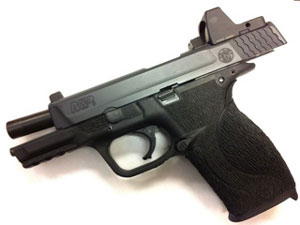
Testing began when I received the Bowie Tactical mounted Trijicon RMR on my M&P. I highly suggest using someone with a depth of knowledge about this subject if you plan to get a gun modified for a red dot sight.
I stated the premise of this two-part article in Part 1: “I think that the future of sighting systems for handguns (both medium-frame carry and duty pistols) are small, lightweight red dot sights (RDS).”
Also in Part 1, I introduced you to (as far as I can find) the “father of Red Dot Sights” on fighting handguns, David Bowie. David runs Bowie Tactical Concepts and was going to be an integral part of my testing and evaluation of a system on a handgun. David agreed to set up my Smith & Wesson M&P with a Trijicon RMR (Ruggedized Miniature Reflex) RDS, with all the features I recommended in Part 1. While this article is not about setting up the gun, I can’t tell you how important it is to have a qualified gunsmith mount and set up your gun to avoid future problems. The slide milling alone is a critical part of the process, and you want to avoid the cheap mounts that cause the sight to sit up too high on the gun. My recommendation? Give David Bowie a call at Bowie Tactical and your worries will be over.
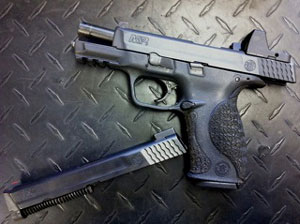
Test pistol was an S&W M&P. Second slide has RMR mounted on it. I used one frame and a second slide to ensure trigger pull and feel were exactly the same.
There’s only one way to find out how the Red Dot Sights compares to a gun with standard pistol sights, and that is to shoot them side by side in the same context and drills. My choice for a base pistol was a Smith & Wesson M&P, because I shoot those guns extensively. I have two guns, one with standard Warren Tactical pistol sights and one with the Trijicon RMR RDS. To further minimize any possible advantages, I decided to do my testing with the slides from both guns mounted on one frame. This should ensure that the grip and trigger feel exactly the same, and that neither gun would have an advantage due to trigger pull. I chose to do the test from a standard belt-mounted holster, a Safariland Model 5188, which is a laminate holster that would accommodate the gun with either slide on it. I decided to also test the RDS handgun from a concealed holster to see if there were any snagging issues associated with the RMR mounted on the slide.
Potential Advantages of Red Dot Sights
My testing would validate or invalidate my previous claims about the potential advantages of a red dot sight on a handgun:
- A red dot sight allows the shooter to continue to focus downrange and simply place the dot on the target.
- A red dot sight can be used more quickly than traditional iron sights. To use irons, the shooter must accomplish multiple things visually, including referencing the front sight, aligning it with the rear, and placing the sights in the center of the target. This is a process that takes time and lots of practice to do quickly. With a red dot, there is only one visual reference to pay attention to — the placement of the dot on the target. Most trainers agree that the shooter should simply keep their focus on the threat/target and not the dot.
- A red dot is much simpler to use. When shooters who have never shot with one are exposed to it, the comment I often hear is, “This is so easy!”
- The cross-over of the dot when using two weapons systems. Imagine a guy like a SWAT officer, who primarily uses a rifle but has to transition to a handgun for close quarters work or if the rifle fails. With a red dot sight, the user transitions from red dot to red dot, and there is no focus shift to a front sight.
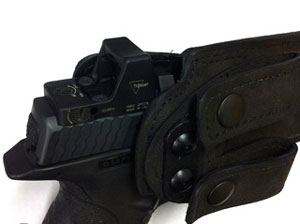
The gun nearly fits in my carry holster. The large rear sight and RMR hit the top of the Safariland Model 18, which will have to be relieved slightly. I expect all major manufacturers to make a holster that will accommodate RDS systems in the near future.
Four Red Dot Sights Tests
If the statements above are to be validated, then testing must reflect the key points I made. My test was a simple shooting test, but I approached it with regard to the points above. My plan was to shoot the two slides on one frame through the following tests, then compare the results as well as my experience.
Modified X-Drill Test
The X-Drill is a two target drill that requires target acquisitions to varying target areas, such as the head and body. This drill allows me to test whether or not shooting with the red dot is faster, since I have to refocus my eyes from the target to the sights several times. The X-Drill was done at the standard distance of 10 yards as follows: Set up two targets at 10 yards, with three yards between them (label them T1 and T2). On the start signal, draw and fire two shots to T1 body, T2 head, T1 head, and T2 body. This test was done for time and I noted my draw times and acquisition times to compare between the RDS and iron sight set-ups.
New Shooter Test
I wanted to see if the RDS is in fact easier for a new shooter to use. For this test, I had a volunteer run a plate rack test that consisted of knocking down six 8” plates from 10 yards. This shows if the RDS has the advantage for a new shooter, and also simulates a situation where it might be beneficial to keep the focal point on the target to verify a hit more quickly.
Rifle/Handgun Transition Test
This is a simple drill to see if transitioning to the RDS is any faster than transitioning with iron sights. For this test, I simulated a target/distance that would require the use of a hard focus on the sights to hit the target. This test was done by setting up a rifle with one round in the chamber and an empty magazine. Transition was done as soon as the dead trigger was recognized, and the split time between the rifle shot and first handgun shot was measured and compared between the guns.
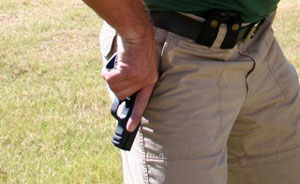
How I would manipulate the slide in certain cases with a standard gun and iron sight (such as the Dawson “charger” sight). How does this work with the RMR on my gun, and does it damage the sight?
One-Handed Manipulation Test
This was important to me because I wanted to see if the RMR would stand up to the rigorous process of working the slide off a belt or obstacle. I shot a series of drills where I was forced to reload the gun as well as clear malfunctions with one hand. This allowed me to use the RMR as my “hook” when working the slide. After the drills, I re-evaluated the sight for damage and to see if it were still zeroed. With the gun set up like Bowie Tactical did it, even if the optic failed, I could use my back-up iron sights.
Let the testing begin!
Test Results
After shooting all the tests with both guns, here are the results. All figures are averages and measured in seconds.
My testing showed the results I had expected. Even though I rarely shoot handguns with optic sights, I have had extensive experience competing with them in the past. This made it very easy to adjust to the RMR sighted pistol, whereas a less experienced person might have had more difficulty. The new shooter on this particular test was Steve Aryan, Director of Training at the U.S. Shooting Academy and an extremely good shooter. Here is what Steve had to say about the RDS optic-equipped handgun.

Most shooters not accustomed to shooting RDS handguns will fail to get their eye low and in line with the scope, often searching for the dot. The trick is to index the gun as if it had hard iron sights, and the dot will be right there. The red dot might disappear in the top portion of the scope if the user makes the mistake of looking slightly high over the gun.
New Shooter Feedback
“Using a dot is something I am very familiar with on a rifle. However, on a handgun, I have little to no real experience with it. When Mike gave me the ‘Bowie edition’ M&P, I extended the gun out and tried to find the dot with little success. I did it again and again and it didn’t get better, because I was extending the gun with the goal of finding the dot rather than extending the gun like I normally do and the dot just simply appearing because of the natural presentation. After I figured that out, it made finding the dot quickly a breeze.
“Target transitions were also faster and easier to do. Tracking the dot is so much easier than tracking a set of irons. Imagine if the front sight post didn’t require itself to be aligned with the rear sight post. As long as you could see your front sight post, the bullet would land right where it was. That’s what you have with the RDS system. As long as you see the dot, that’s where the bullet is going to go. I found that to be a huge advantage over my iron sights. After spending a week with the RDS-equipped M&P, my conclusions are:
- Red Dot Sights are a great addition to the iron sights but not a replacement. Just like a rifle, you need to add an ‘optic failure’ drill into your training regimen.
- Choosing an RDS that’s sturdy and can hold up to one-handed manipulations is not questionable. I found the RMR to be one of the best choices on the market today.
- Choosing a holster that fits the RDS-equipped weapon is important. Not all holsters fit such a setup. I found my Raven Concealment holsters fit perfectly without any modification.
- As a new RDS shooter, I found not looking for the dot harder. Most of my students who had an opportunity to fire this M&P also found themselves looking for the dot rather than extending the weapon out. Once they got over that, they loved it.
In the end, I adapted to the sight very quickly!”
Conclusions
RDS-sighted handguns offer a huge benefit to the defensive shooter, whether they be in law enforcement, the military, or a concealed carry holder. I think the system offers significant benefit if the right scope is picked and would prioritize those benefits in this order:
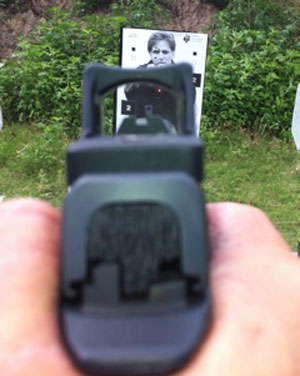
Red dot offers the ability to focus clearly on the threat, with a strong awareness of where the red dot is at all times. Red dot is in the upper right corner of the scope, and yet you can still tell that the dot is in the center of the chest, all while visually focusing on the threat. This is a huge advantage, since the human vision system is hard-wired to focus on the threat when under stress.
1. An RDS-sighted handgun offers the shooter the ability to use what human development makes natural, a threat-based focus. When under stress, this may be a huge benefit, since there will be no need to bring the focus back to a set of front and rear sights to get a hit on a target that requires it. Those who are of the age at which their vision will not allow a good sight picture will appreciate this sight even more. During testing, I was reminded how I could keep a clear focus on the threat target while maintaining awareness of where the dot was if the handgun were somewhat in front of my face. This can be an advantage in cases where you are still assessing the person during the decision-making process, and would allow for a quicker first shot once the decision to shoot has been made.
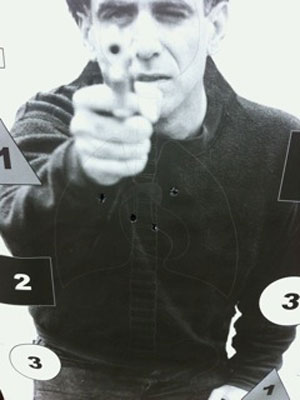
I began testing with the RDS-sighted handgun. These were my first four shots all timed at less than one second (with a laminate holster, unconcealed). The red dot was surprisingly easy to pick up.
2. An RDS-sighted handgun gave me a speed advantage when shooting it, and with some training I am sure it would with any user. The dot is simply an easier way to aim and align the gun. There is no focusing back and forth to find the sights and ensure they are aligned. Simply find the dot, line it up with the target area, and press the trigger. The time differences can be seen in the results chart, especially during the draw at 10 yards. I was able to go faster because I did not have to bring my visual focus back to the front sight, which took several tenths of a second. Competition shooters have long known the huge advantage of using a dot scope in handgun matches. The sport was divided into divisions once the dot scope made its way onto handguns in the late 1990s. There soon became an open (optic sights) division, and a limited (iron sights) division, because iron sights simply cannot compete with optic sights in those situations. About the only place they are even is at extreme close ranges where the shooter doesn’t really need a dot or sights to hit the target.
3. An RDS-sighted handgun offers the same sight picture and visual focus that most defensive shooters would see when using a rifle with an optic on it. This may lead to more commonality in what the user sees when transferring from one gun to the other for a malfunction, etc. I have found it very hard to bring my focus from threat-based when using an optic back to the front sight on a handgun when necessary. There is a dramatic visual focus shift, and an RDS-sighted handgun eliminates this.
4. An RDS-sighted handgun offers some unique side benefits, such as an increased learning curve for new shooters and additional visual feedback for experienced shooters. A new shooter may have to learn to extend the gun and find the dot, but once they do, they have an easier time shooting a red dot than iron sights. During my testing, I was reminded how the red dot is a unique feedback tool and that it allows you to see more of the gun movement than you normally would with iron sights because of its brightness. Long ago, professional shooter Todd Jarrett told me that using an open gun might improve my shooting due to the feedback the dot gave. This may allow you to get more visual feedback from your training drills and improve faster.
As you can see, there are some direct benefits to using a gun set up like mine. After much testing and evaluation, I stand by my initial statement that RDS-sighted handguns are the way of the future. I wish this was an original idea, but the truth is that David Bowie, Gabe Suarez (and a bunch of folks on his Warrior Talk forum), and many others since the late 1990s have been developing the concept of using a red dot on a fighting handgun.
Until recently, I would have hesitated to try simply because I did not think the sighting systems were up to it. I have not tested all available RDS systems, but can tell you the Trijicon RMR is up to the task, and I can honestly say: “Red-dot sights are the future of defensive handguns!”
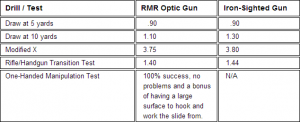

All good but I have not yet seen any comments about using an RDS with a light. My home defense hand gun has a laser/light mounted under the trigger guard under the muzzle. That is one place to go to turn it on. With the RDS on the slide and a light under the muzzle that gives me two places to go. That takes time. What am I missing?